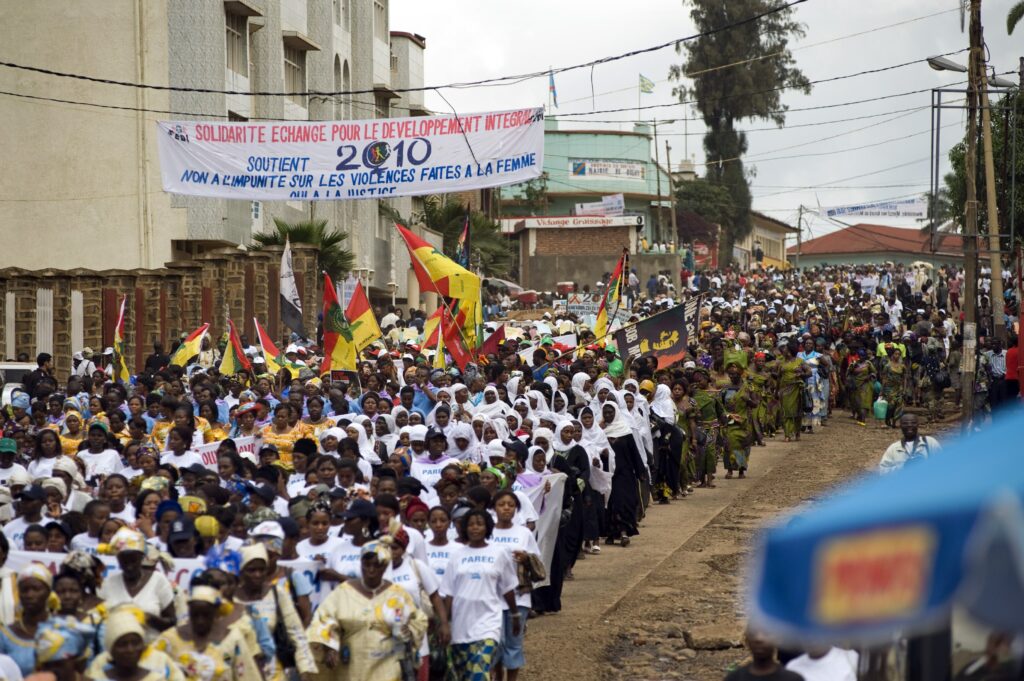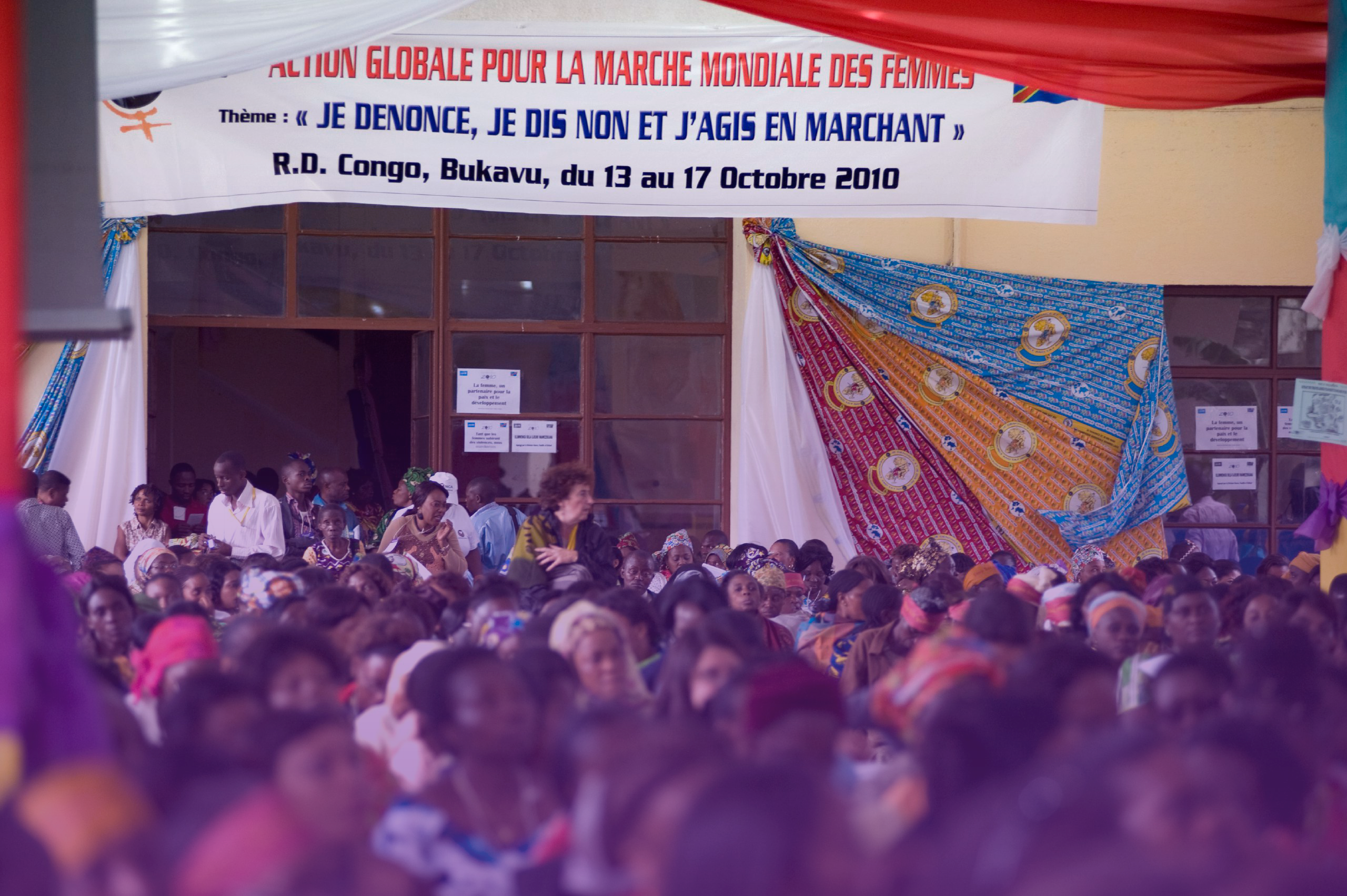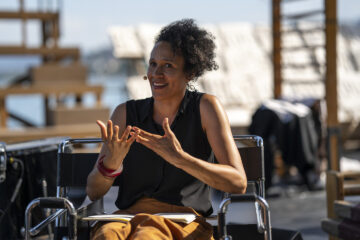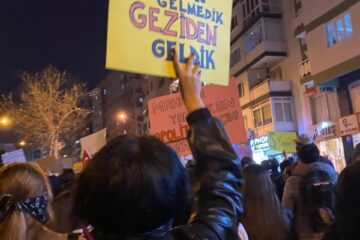On International Day of Struggle for the Elimination of Violence Against Women, November 25th, we look back at the political formulation of the World March of Women dedicated to this struggle. The action area on violence against women was collectively built in preparation for the movement’s 3rd International Action, in 2010, side by side with three other action areas: peace and demilitarization, the common good and public services, work and economic autonomy. The action areas express the political synthesis of that period and have guided the political action of the World March of Women ever since.

Twelve years later, the bases of this document remain in effect. Capire spoke with members of the International Committee of the World March of Women about the challenges faced to update the strategies to fight violence against women in today’s scenario.
Elements of continuity in the action area include the political view that the feminist strategy against violence must be focused on fighting its cause, not just tackle its effects. Nalu Faria, who represents the Americas in the International Committee, argues that “struggling against violence is about challenging the patriarchal system, as it is imbricated with capitalism, racism, colonialism, and LGBT-phobia.” The document underscores that violence affects all women as a social group, but it is very connected to specific contexts, in intersection with different forms of oppression women experience due to their class, race, and sexuality. Nalu points out how important it is to understand the challenges of the struggle against violence as the capital-life conflict escalates. Violence, racism, and militarization have been used as tools to expand the control over bodies, labor, and territories.
The link between violence, militarization, and the advance of capital is a challenge Luciana Alfaro and Marianna Fernandes, representatives for Europe, point out. The two militants underscore the violence perpetrated on militarized borders and denounce the precarious conditions migrant women are subjected to as they sustain part of social reproduction in Europe. The flows of transnational capital accumulation are connected to the violation of rights and dispossession in countries in the South: “as feminists who inhabit this region, it is also up to us to denounce the corporate power of European capital’s transnational companies, which operate with impunity in territories in the South.” Luciana and Marianna also point out how necessary it is to “acknowledge and show feminist solidarity with sisters who are being criminalized, threatened, and abused by states and transnational power for denouncing and resisting them.”
Violence against women is used as a war weapon. Bushra Khaliq, a representative for Asia and Oceania, argues that women face brutal situations due to military interventions by the United States and the North Atlantic Treaty Organization (NATO). In 2010, the action area challenged the instrumentalization of the defense of women’s rights, used as a “justification” to legitimize imperialist strategies of occupation, war, and sanctions. The document expressively mentioned Afghanistan; today, more than a decade after the US occupation of the country and one year after the US withdrew from it, leading the Taliban to rise to power again, Afghan women are facing restrictions against all aspects of their lives. “We should keep Afghanistan in our minds, hearts, and voices. We cannot accept those kinds of restrictions.”
Looking back at the action area of the World March of Women on violence allows us to assess what we have accumulated and the challenges facing this struggle. One of the aspects that marks the time when the document was produced is that it required a footnote to explain the term “femicide,” defining it as “the misogynistic, exceptionally brutal genocide of women, often accompanied by extreme sexual violence and impunity for its perpetrators.” Women’s struggles have now allowed the world to learn about the political meaning of this word—and the brutality of its reality.
The critique of the commodification of bodies and the control over sexualities is an integral part of the struggle against patriarchal violence under neoliberalism. Another aspect that marks the time when the document was drafted was the need to denounce the dynamics of violence in the capitalist and heteropatriarchal model of organization of the FIFA Men’s World Cup. In 2010, the event was hosted by South Africa and feminists exposed the increase in trafficking and sexual exploitation of women. In 2022, the event is taking place in Qatar, and there are reports of violence, violation of rights of women and LGBT+ people, and exploitation of migrant workers in the country. Bushra argues that “transgender and LGBT people are really under threat, their lives, their spaces and their voices are under threat,” and this reality goes way beyond Qatar.
The political view of the World March of Women on tackling violence points to the need to fight for public policies and justice, aiming to change the model globally, facing the causes of poverty and violence. This is why its strategic bid is to empower self-organization and solidarity between women, as well as strengthen alliances to incorporate the struggle against violence into the agenda of mixed-gender movements, as does La Via Campesina. Bushra says that feminism today brings a lot of hope, “because there is resistance and mobilization, facing including repressive actions. We are marching for our freedom and we’ll continue our struggle until we all are free.” Read below the document on the action area of the World March of Women.

Violence against women
Action area – World March of Women – 2010
Violence against women is structural – it is an inherent feature of the patriarchal and capitalist systems – and is used as a tool of control of the lives, bodies and sexuality of women by individual men, groups of men, patriarchal institutions and States. Although it affects all women as a social group, each violent act has a specific context, and we have to understand how, when, and why violence against women occurs.
The general belief about violence against women is that it is an extreme or isolated situation involving individual people. Whereas, on the contrary, it affects us all because we all have experienced fear, changed our behaviour, and limited our options due to the threat of violence. Another common idea is that violence against women is a problem limited to low social classes and to “barbarian” cultures, but we know that this kind of violence is transversal, that it cuts across all social classes, cultures, religions, and geopolitical situations.
Although violence against women and girls is more common in the private sphere – as domestic violence, be it sexual, physical, psychological or sexual abuse – it also occurs in the public sphere, including (but not limited to): feminicide, sexual and psychological harassment in the workplace, different forms of rape, the commodification of women’s bodies, trafficking of women and children, prostitution, pornography, slavery, forced sterilisation, lesbophobia, denial of safe abortion and reproductive options and self-determination, etc. Silence, discrimination, impunity, women’s dependence on men, and theoretical and psychological arguments tolerate and aggravate violence against women.
Violence, or the threat or fear of violence, is used as a way of excluding women from the public sphere. Women pay with their lives for working outside the home instead of staying within the private sphere as dictated by patriarchal culture, for going to school or university, for ‘daring’ to live their sexuality openly, for prostituting themselves for lack of options. In the context of criminalisation of social movements and of protest, repression against women activists engaged in the struggle often takes the form of sexual violence. Furthermore, discrimination against women is compounded by the intersection of different modes of oppression: they are discriminated against for being women, but also because of their skin colour, language, race, ethnicity, class (and financial situation), religion, sexuality…
Violence against women is rooted in the patriarchal system and in capitalism, which impose the need to control, to own, and to exploit women’s bodies, lives and sexuality. Patriarchy is based on two principles: women belong to men (and for this reason, women are in the service of men and can never say “no” to them), and the division of women into categories: “saints” and “sinners”. As part of this system, violence is the punishment for women who do not fit the role of “saints” – of good mothers and wives. For example, it is common for men to justify verbally or physically attacking their wives because the food was not ready or the clothes they wanted to wear were not clean. It is also punishment for those who are considered “sinners”, with both aggressors and societies justifying sexual violence against women on the basis that ‘they were out alone at night’, or ‘they are lesbians and need to be taught to be heterosexual’, or ‘the clothing they were wearing was indecent’.
As part of the patriarchal culture, masculinity is associated with aggressiveness, and young men are taught that to be violent (and not to show emotions) is to be a ‘real man’, leading – in some cases – to them joining racist and sexist gangs. New forms of violence against young women, such as sexual harassment against female students and group violence in schools, are becoming more common and more visible each day. These forms of violence form the basis of sexist relationships and roles between young women and men, without any kind of public discussion around these devastating stereotypes.
The idea imposed by patriarchy – of women as the property of men – includes an economic aspect that is expressed in the union of patriarchy with capitalism, imposing a sexual division of labour with ‘natural’ roles for women and men. In this way women are regarded as free labour in the reproductive sphere, always available for the care of others and all the work this entails.
There are therefore two levels of women’s domination within the patriarchal and capitalist systems: on the one hand, women’s labour is exploited, and on the other, violence is used to maintain their domination by men. And therefore we cannot talk about the eradication of violence against women without calling for the eradication of the patriarchal, capitalist, and colonial systems.
Violence against women and misogyny intensify as the policies and actors of neoliberal globalisation entrench their hold on the economy. Feminicide increases as free-trade agreements in the Americas are promoted and set in place (such as North American Free Trade Agreement under which work spaces, such as factories, enjoy lax human resource and environmental regulations): huge numbers of Mexican women are killed, for example, when they try to cross the United States border and within the border town of Ciudad Juarez itself. The attack on reproductive rights and health services has been on the rise as social services are privatised or their budgets slashed. Younger and younger girls are trafficked as the sex industry is globalised. Women are raped in wars waged in the name of ‘spreading freedom’, and invasions are carried out by foreign powers (such as the invasion of Afghanistan by the USA) ‘justified’ by the defence of women’s rights.
How can we fight violence against women?
In many countries, there are laws and international conventions such as CEDAW (Convention on the Elimination of all forms of Discrimination against Women) that “protect” women, but they are not sufficient because they are often not enforced or put into practice. Moreover, these laws and conventions focus the issue of violence on women, as if it was our problem to deal with, whereas – on the contrary, and as we have seen above – we need to question men’s role in violence and denounce the fact that violence is structural.
We recognise that punitive measures against perpetrators are necessary, but not sufficient, to eradicate violence; in those countries where they do exist they rarely reach women who do not fall into the middle-class, urban, white category. We have to hold our States accountable, to demand public policies for violence survivors, for trafficked women and children, for minority groups (women of colour, of a certain religion, etc), rural, migrant and indigenous women. Actions are needed to prevent and inhibit acts of violence before they occur.
We also need to discuss the role of governments and States. Nowadays, the State is simultaneously protector and oppressor, at the same time bearer of general interests and defender of privileges, but it is also patriarchal and violent (against women, indigenous people, immigrants, people of colour). Moreover, the very same police who enforce many of the policies we demand, are themselves perpetrators of violence against women, repressors of social movements, and are socially and racially biased. We recognise the contradiction inherent in this situation, because the fact is that for many women the only way they can defend themselves against violence in their communities and families is to rely on the State, which represents an external and superior power. On the contrary, the State that we demand is one that promotes freedoms and rights for all, intervenes in the economy, and is structured on diversified forms of participative democracy and control by its citizens.
Women have always resisted, and continue to resist, both individually and collectively. Whenever a woman acts in such a way that she defies or denounces violence against her or women in her community, she is breaking away from the dominant paradigm. We need to support her resistance by condemning and naming men who commit violence against women, and publicly confronting men and society on the issue of violence against women. We also need to denounce the complicity of men, the State and institutions such as the army and religions. We need to mobilise civil society, strategise, and promote radical actions for the prevention and denouncement of male violence against women. In this process, the women’s not-for-profit sector – that provides services that are essential to women’s healing and empowerment – and strong, local movements – in which community women are protagonists – play a decisive role.
We, women of the World March of Women, want to engage in broad political debates and actions that promote changes in our patriarchal cultures and anticipate the occurrence of violence, in this way being truly preventative.
The extent and intensity of male violence against women is already well documented, therefore it is not necessary to wait for yet another denouncement. More vital is to get this issue on the agenda of women’s groups, mixed organisations, community radio programmes, newspapers, and other means of communication used by movements. In order for this to occur, we believe that the feminist movement should work towards the promotion of strong, wide-ranging self-organisation of women struggling for autonomy (economic, sexual, reproductive, personal, etc) and self-determination.
Women’s groups are strengthened through group conversations, debates, demonstrations, and corporal self-defence classes. The objective is not to situate sexual violence as the problem of only a few women, but to strengthen all women, learning and re-learning to resist and to build and re-build our lives without violence.
We value, as an important step in this struggle, the fact that mixed social movements – be they urban or rural – are committed to confronting male violence against women. To this end, we declare our solidarity with Via Campesina’s ‘World Campaign to end Violence against Women’ that was launched at their 5th International Conference held in Mozambique in October 2008. We acknowledge the importance of both women andmen holding men accountable for violence against women.
In the fight against violence against women, we demand:
• The adoption of measures that demonstrate different actors’ full commitment to the recognition of women as individuals and citizens with full rights, from childhood onwards. For example: the use of inclusive language in didactic material, the promotion of non-sexist education that breaks with traditional sexual and hierarchical role divisions between girls and boys, popular education campaigns and the guarantee of spaces for political participation;
• The financial support of women’s movements and the women’s not-for-profit sector, who are at the forefront of supporting survivors of discrimination, abuse and violence;
• That commercial media, as the spokesperson of the patriarchal and capitalist systems, is held accountable for the continued misrepresentation, misappropriation and abuse of the female body;
• The prevention of violence against women and girls through awareness-raising activities, making clear how it occurs, what its causes are, and how it manifests itself, as well as through the support and encouragement of women’s auto-organisation;
• The condemnation of the systematic use of women’s bodies as weapons of war in armed conflict, as well as the rejection they (and their children born of rape) face from families and communities, taking the blame for the extreme violence they have suffered;
• The punishment of the perpetrators of violence – whether it be in the private or the public sphere – against women.
And we commit ourselves to:
• Denounce the varied expressions of patriarchal violence against women in different countries, such as (but not limited to): feminicide, genital mutilation, levirat-sororat1, ‘honour killings’, sexual tourism, trafficking of women and children, forced sterilisation, and violence perpetrated against female activists, women prisoners, lesbians and women with disabilities;
• Work to shift the stigma from women survivors towards male perpetrators of violence;
• Denounce the commodification of women’s bodies and to continue the debate around prostitution, particularly before and during the World Football Cup in 2010;
• Make visible all forms of women’s resistance – especially collective – to male violence against women, in this way breaking the culture of silence that surrounds this violence in our communities;
• Combat violence through awareness-raising actions together with allied social movements, and popular education campaigns that favour feminist consciousness-raising;
• Make visible the links between patriarchal policies that perpetuate violence against women (such as impunity for aggressors, denial of reproductive auto-determination, criminalisation of women activists, prohibition of abortion, etc) and neo-liberal actors and policies. To call attention to feminicide, for example, and its links with free trade agreements;
• Work in alliance with mixed social movements (in which men and women participate) in order to guarantee the construction of an environment in which violence against women is not acceptable (and physical spaces free from violence) as a guiding principle of these movements.
- The forced marriage of a widow to her brother-in-law or of a widower to his sister-in-law. [↩]




